Physical Address
304 North Cardinal St.
Dorchester Center, MA 02124
Physical Address
304 North Cardinal St.
Dorchester Center, MA 02124
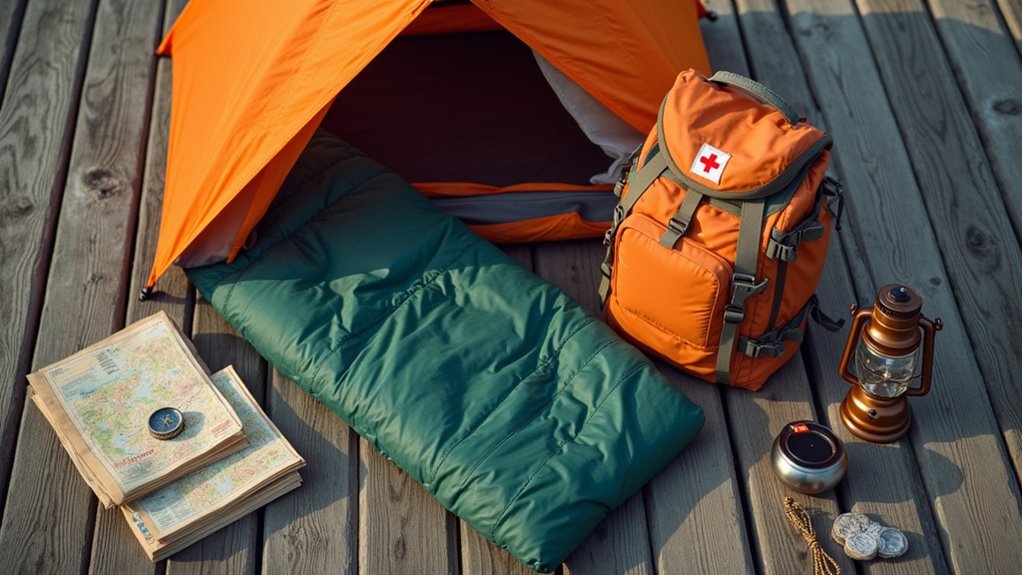
Take your camping trip from miserable to memorable by learning these essential gear basics that experienced outdoorsmen swear by.
When Sarah forgot her sleeping pad on her first backpacking trip, she learned the hard way that basic camping gear can make or break your outdoor experience. You should aim to avoid common beginner mistakes that can turn your adventure into a miserable ordeal. While you don’t need to spend a fortune on equipment, understanding the essential gear basics will help you stay comfortable, safe, and prepared in the wilderness. Let’s explore what you actually need and what you can leave behind.
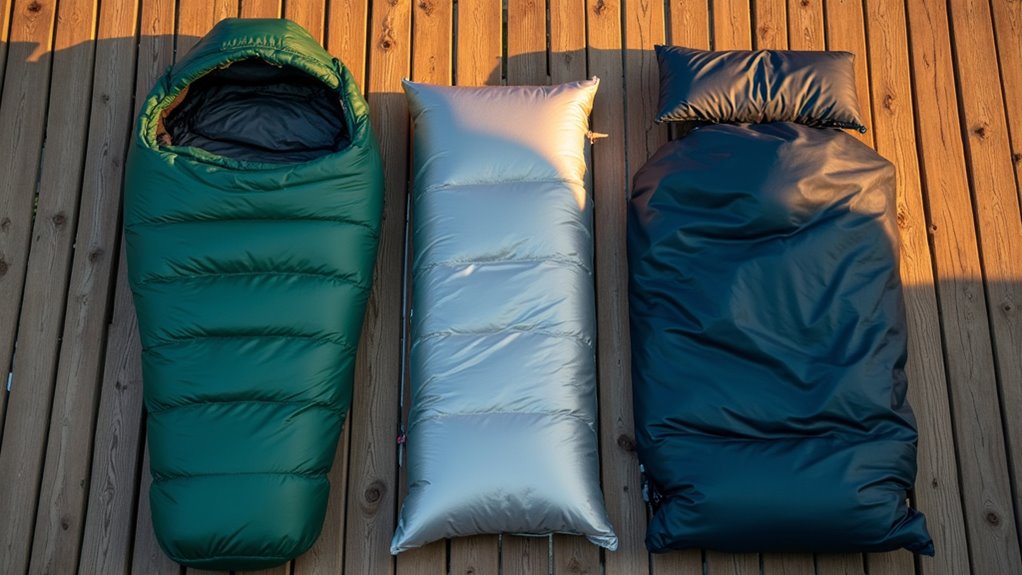
Three essential shelter options form the foundation of a comfortable camping experience: tents, hammocks, and tarp setups.
Tents remain the most versatile choice, offering protection against various weather conditions while providing ample space for you and your gear. Always bring extra tent stakes and a mallet for proper assembly. Look for models with multiple entrances and good ventilation to enhance comfort. Choosing the right camping sleeping bag is crucial for a comfortable night’s sleep.
If you’re camping in warmer climates, consider a hammock with a mosquito net and rain tarp – it’s lighter and often cheaper than traditional tents.
For experienced campers, tarp shelters using hiking poles and Dyneema guylines offer a lightweight alternative that’s highly adaptable to different environments.
Don’t forget your sleeping system: pair your shelter with an appropriate sleeping bag and pad.
This combination will protect you from ground moisture and guarantee you stay warm throughout the night.
Proper lighting can make or break your camping experience, serving as both a safety essential and a practical necessity for nighttime activities.
Good lighting isn’t just a camping luxury – it’s a vital tool that enhances both safety and enjoyment in the great outdoors.
You’ll need a combination of personal and general lighting solutions. Start with a reliable headlamp for hands-free tasks like cooking or reading, and pack a sturdy flashlight as backup.
For campsite illumination, invest in a quality lantern – either battery-powered or rechargeable LED models offer the best value. Keep a fireproof container nearby when using battery-powered lanterns to safely store spare batteries and prevent fire hazards. The best camping lanterns can illuminate your outdoor nights effectively.
Solar-powered lights are great eco-friendly additions that’ll help reduce battery waste while providing ambient lighting.
Don’t forget about emergency options; a crank-powered light can be invaluable if your batteries fail.
Consider brightness adjustability when choosing your lights – you’ll want options for both focused task lighting and softer general illumination to navigate safely around your campsite at night.
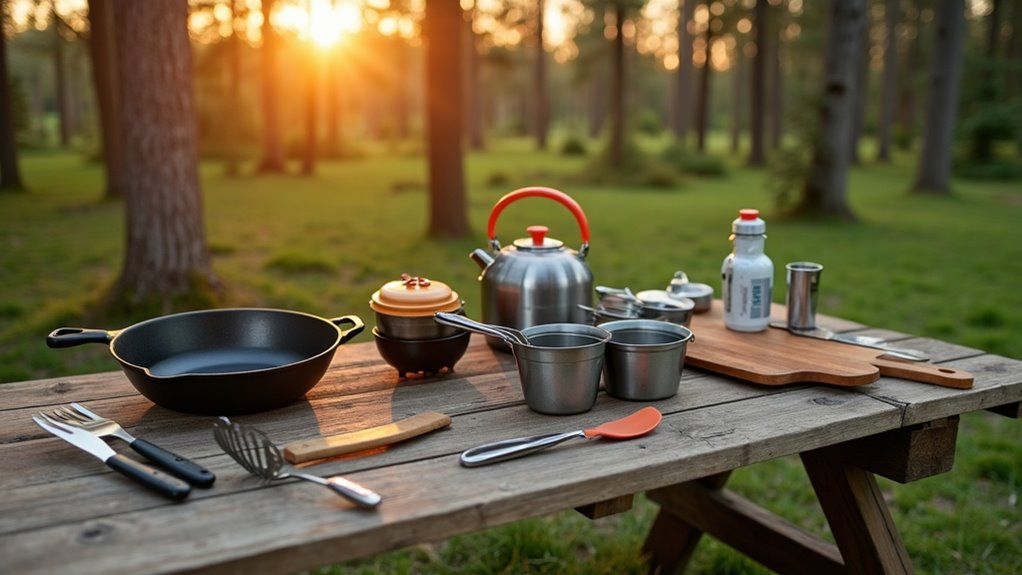
When planning your outdoor kitchen setup, a well-organized layout becomes the foundation for enjoyable camp cooking. Start by mapping out your space, ensuring you’ve got room for your stove, prep table, and storage areas. You should aim to position your cooking equipment away from your tent and create a dedicated food prep zone.
For cooking gear, invest in a reliable portable stove or compact grill, and pack essential cookware that serves multiple purposes. Keep your supplies organized with stackable bins and collapsible containers – they’ll save space in your vehicle. A two-burner stove is particularly ideal for car camping, giving you more cooking flexibility. Mastering camp cooking in your outdoor kitchen can elevate your camping experience.
Don’t forget to include a water station with a portable sink or large jug.
For safety and comfort, set up a canopy to protect your kitchen from weather, and install windbreaks if needed. Always keep cleaning supplies and a fire extinguisher within reach.
Maintaining personal hygiene during camping trips isn’t just about comfort – it’s essential for your health and safety in the wilderness. Pack unscented, alcohol-based hand sanitizer and biodegradable soap for basic cleanliness, and remember to use soap at least 100 meters from water sources. Moisture-wicking clothes help keep you fresh and minimize body odor during your outdoor adventures.
You’ll need a travel-size toothbrush, toothpaste, and dental floss to keep your mouth healthy. For washing without showers, bring biodegradable wipes and quick-dry microfiber towels.
Store all scented products in bear-proof containers, and pack sealable bags for waste disposal. Don’t forget sunscreen and moisturizer to protect your skin from environmental damage. Proper hygiene practices are an essential part of a great outdoor experience.
If you’re planning an extended trip, bring extra supplies and consider using a menstrual cup to minimize waste. Always carry out what you bring in to protect the environment.
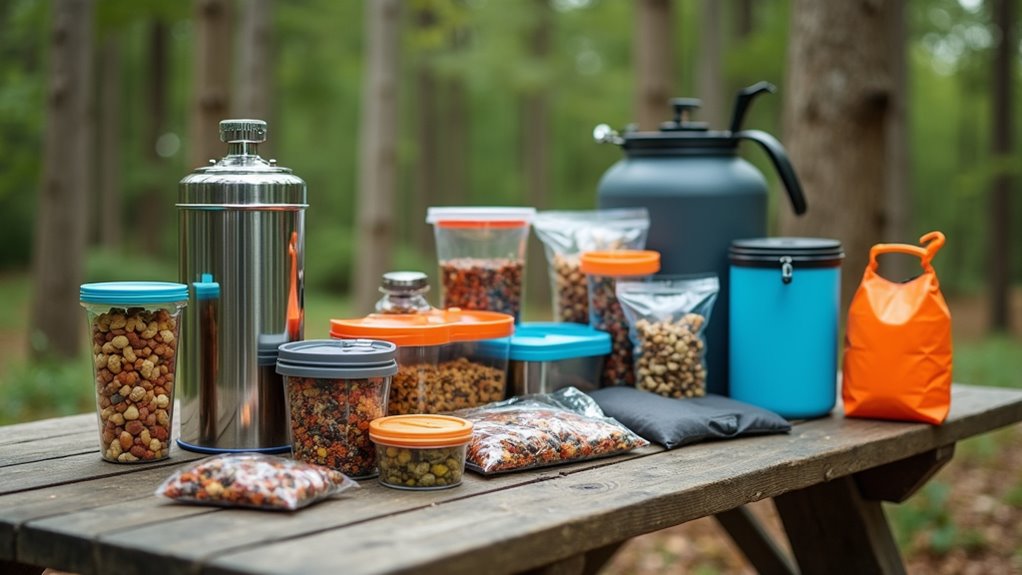
Smart storage solutions can make or break your camping experience, especially when it comes to protecting your food and water supplies from wildlife, weather, and contamination.
When camping in bear country, you’ll need to use metal bear-proof containers or hang food bags at least 10 feet high. For water storage, consider investing in collapsible containers or jerry cans that won’t take up much space when empty.
Choose airtight containers to keep your food fresh and organized, and don’t forget to use food bag liners for extra protection against moisture. Cook away from tents to minimize attracting wildlife to your sleeping area. Camping water filters can be essential for purifying water and ensuring a safe drinking supply on longer trips.
For longer trips, water filtration systems and larger capacity tanks might be worth the investment. Always check local regulations about food storage, and remember to clean your containers regularly to prevent bacterial growth.
These practical solutions will help you maintain a safe, waste-free campsite.
A well-organized campsite goes beyond just storing food and supplies – it’s about creating a functional outdoor living space that maximizes comfort and safety.
Start by dividing your site into distinct zones for sleeping, cooking, and socializing. Place your tent on flat, clear ground, ideally in a shaded area that’s protected from wind. Consider using trip-ready gear totes for quick access to essential cooking and camping supplies.
Strategic zoning of your campsite creates natural flow and comfort, while smart tent placement ensures peaceful, protected rest.
Position your campfire at a safe distance from tents, following local regulations, and create clear pathways between areas. You should aim to keep communal gear in a central location that’s easily accessible to everyone. When choosing a camping tent, select one that suits the number of people, climate, and activities planned for your trip.
Make smart use of vertical space and multi-purpose furniture to save room. Don’t forget to take into account the sun’s path when setting up – your tent’s position can make the difference between a comfortable or sweltering afternoon.
Keep frequently used items within reach and organize supplies using labels and containers.
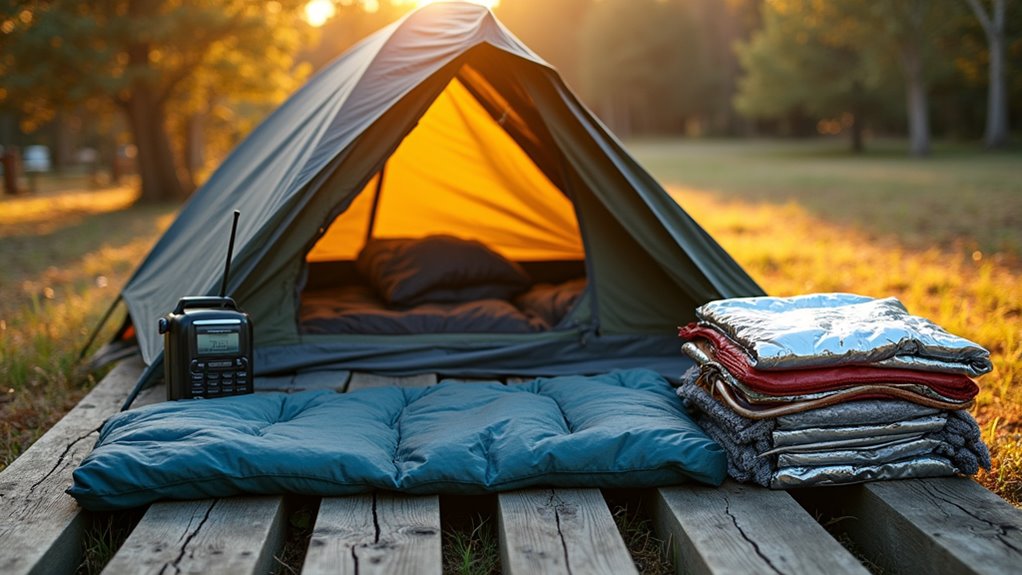
Because weather conditions can change rapidly during camping trips, proper protection and climate control gear becomes essential for both comfort and safety.
Start with moisture-wicking base layers and quick-drying clothing to manage sweat and prevent chilling. You’ll need a waterproof jacket and pants made from breathable materials like Gore-Tex, along with sealed seams and adjustable hoods for effective rain protection. Layering clothing helps adapt to changing temperatures throughout your camping adventure.
Don’t forget proper footwear – water-resistant hiking boots paired with moisture-wicking socks will keep your feet dry and comfortable.
Your tent should include a waterproof rain fly and ground footprint, plus adequate ventilation to control condensation. Winter camping can be an exhilarating experience when you have the right gear.
For temperature regulation, pack layered clothing options including long underwear and insulated jackets.
Remember sun protection too – a wide-brimmed hat and sun-protective clothing will shield you from harmful UV rays.
While protecting yourself from the elements is important, having the right tools and emergency supplies can make the difference between a minor inconvenience and a serious situation.
Always pack a multi-tool or pocket knife, along with a basic repair kit for your tent and sleeping pad. Don’t forget essential safety items like a first aid kit, flashlights, and extra batteries. Make sure to take a First Aid and CPR class to properly handle emergencies.
Keep emergency tools like duct tape, paracord, and zip ties handy – they’re invaluable for quick fixes around camp.
For your campsite setup, you’ll need a mallet for tent stakes and possibly stabilization equipment if you’re bringing an RV.
Remember to pack navigation tools like maps and a compass, even if you’re planning to use your phone. These items don’t need to be expensive, but they should be reliable and easily accessible.

Responsible camping starts with understanding your impact on the environment. You’ll protect natural spaces by choosing established campsites, using eco-friendly gear, and following Leave No Trace principles. When you camp, select spots at least 200 feet from water sources and use biodegradable products to minimize pollution. With 18% of campers now choosing off-grid experiences, minimizing environmental impact has become increasingly important. Embrace Responsible Camping for a greener camping experience.
Remember to separate recyclables when facilities are available, and never feed wildlife or disturb natural features.
These practices help preserve camping areas for future generations while keeping costs down through reusable gear.
Properly planning your purposeful packing will make your camping experience safer and more enjoyable. You’ll find that focusing on fundamental gear first – shelter, lighting, and cooking equipment – saves money while maximizing comfort. Don’t forget to develop your outdoor skills alongside your gear collection. With careful consideration of these camping basics, you’re ready to create countless memorable moments in the magnificent wilderness.